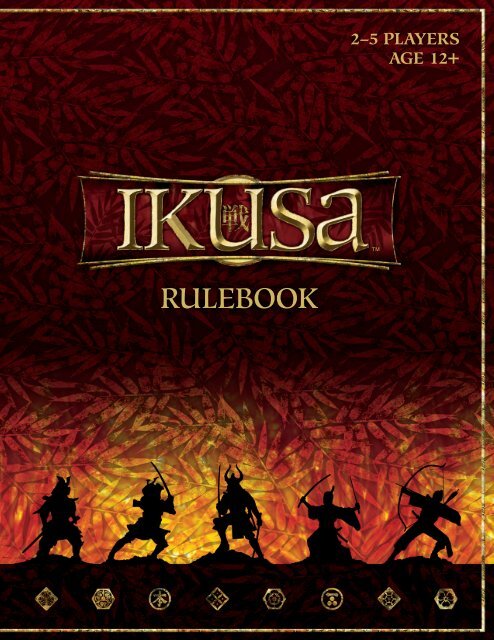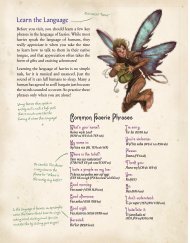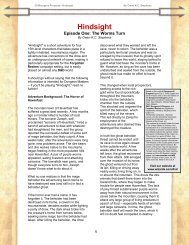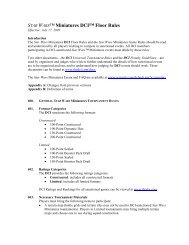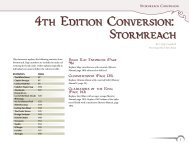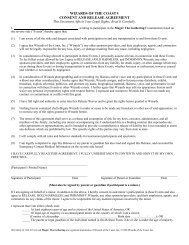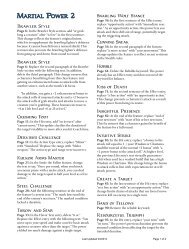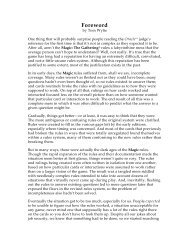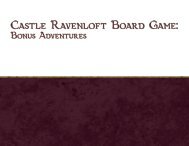Ikusa Rulebook (12 mb pdf) - Wizards of the Coast
Ikusa Rulebook (12 mb pdf) - Wizards of the Coast
Ikusa Rulebook (12 mb pdf) - Wizards of the Coast
- No tags were found...
You also want an ePaper? Increase the reach of your titles
YUMPU automatically turns print PDFs into web optimized ePapers that Google loves.
2–5 PLAYERSAGE <strong>12</strong>+TMRULEBOOK
It is <strong>the</strong> sixteenth century—<strong>the</strong> Age <strong>of</strong> Warin Japan. On <strong>the</strong> provincial battlegrounds,daimyo leaders draw up <strong>the</strong>ir armies.Samurai warriors don battle armor; peasantfarmers take up spears and guns. For eacha<strong>mb</strong>itious daimyo, a lifetime <strong>of</strong> militarytraining is put to <strong>the</strong> final test. Who willemerge victorious?As a Japanese warlord, you lead yourdaimyos to victory—or defeat! Conquerprovinces, <strong>the</strong>n guard <strong>the</strong>m well while youconquer more. Each enemy, each battle, callsfor a different strategy. Is brute military forceenough? Will your opponent honor a truceline? Could a samurai ronin a<strong>mb</strong>ush or asudden ninja strike pay <strong>of</strong>f?Whatever your strategy, each province youclaim brings you closer to your goal.Gain enough provinces, and you becomeShogun—military ruler <strong>of</strong> all Japan!TMThird Edition <strong>of</strong> a Classic Game<strong>Ikusa</strong> was first published by Milton Bradley as part <strong>of</strong> <strong>the</strong> popular Gamemaster series <strong>of</strong> games. Originallyreleased as Shogun in 1986, it was later released as Samurai Swords in 1995,and once again <strong>the</strong> game finds itself with a new name.This latest edition features updated components and fresh art that brea<strong>the</strong> new life into <strong>the</strong> game.We hope you enjoy playing it as much as we do.2
Object <strong>of</strong> <strong>the</strong> GameTable <strong>of</strong> ContentsObject <strong>of</strong> <strong>the</strong> Game .....................................................3Components .................................................................4Setup ........................................................................... 10Action Sequence......................................................... <strong>12</strong>1. Plan ...................................................................... <strong>12</strong>2. Determine Turn Order ........................................ <strong>12</strong>3. Build .................................................................... 134. Levy Units ........................................................... 135. Hire Ronin ........................................................... 156. Hire Ninja ............................................................ 167. Wage War ............................................................ 17Phase A. Move Daimyos’ Armies ...................... 18Phase B. Declare First Battles ............................ 19Phase C. Conduct Co<strong>mb</strong>at ..................................20Phase D. Final Movement ...................................278. Remove Ronin .....................................................289. Collect Koku .......................................................28Winning <strong>the</strong> Game ....................................................28Two-Player Rules ....................................................... 29Quick-Play Rules ....................................................... 29The object <strong>of</strong> <strong>Ikusa</strong> is to be <strong>the</strong> first player to gain control <strong>of</strong> 35 provinces. All players begin <strong>the</strong> game with <strong>the</strong>same nu<strong>mb</strong>er <strong>of</strong> provinces. You’ll gain more by capturing <strong>the</strong>m from your opponents.First, outplan your opponents by spending your wealth wisely. Will you recruit more military units? Or hire <strong>the</strong>deadly ninja to assassinate your enemy? You decide. Then bid cleverly and position your military units skillfully.You’ll need a handful <strong>of</strong> luck on your die rolls to eliminate enemy military units and claim ano<strong>the</strong>r province.Diplomacy can become an important part <strong>of</strong> your strategy in this game. Depending on your starting position, youmay need to negotiate a temporary truce with at least one opponent or your domain will quickly diminish. Bewary <strong>of</strong> your allies, however: in <strong>Ikusa</strong>, no one can be trusted!3
Components1 Game Board1 <strong>Rulebook</strong>5 Reference Screens5 Army Cards5 Planning Trays1 Master Tray10 Castles5 Castle Fortifications30 Koku Chips30 Ronin Figures1 Ninja Figure5 Turn Order Markers72 Province Cards<strong>12</strong> Battle Markers1 Flag-Label Sheet6 Twelve-Sided Dice5 Colored Sets <strong>of</strong> 72 Military Figures**Each colored set contains 36 Ashigaru Spearmen, 9 Ashigaru Gunners, 9 Samurai Swordsmen, 9 Samurai Bowmen,6 Flag Bearers, and 3 Daimyo.4
Sea LineThe Island <strong>of</strong> HonshuFGDHCEABThe Island <strong>of</strong> KyushuThe Island <strong>of</strong> ShikokuGame BoardThe game board is a modified map <strong>of</strong> feudal Japan.The letters on <strong>the</strong> above diagram are used below in thissection for examples.Islands: The map shows three <strong>of</strong> Japan’s large islands:Honshu, Shikoku, and Kyushu. They are not labeled on<strong>the</strong> actual game board, but are called out on <strong>the</strong> abovediagram.Provinces: Provinces are divided by thin black borders.Each province is a game space. Note that <strong>the</strong>re are twoprovinces named Awa: one (A) is located on <strong>the</strong> island<strong>of</strong> Shikoku, and <strong>the</strong> o<strong>the</strong>r (B) on <strong>the</strong> island <strong>of</strong> Honshu.Adjacencies: Attacks and military unit movement canonly be made to and from adjacent provinces. Provincesthat share a common border are adjacent to each o<strong>the</strong>r;provinces that meet at a single point are not adjacentto each o<strong>the</strong>r. For example, <strong>the</strong> provinces <strong>of</strong> Kōzuke(C) and Echigo (D) are adjacent, but <strong>the</strong> provinces <strong>of</strong>Kōzuke (C) and Shimosa (E) are not adjacent.Sea Lines: The blue lines connecting certain provincesacross water are sea lines. Provinces connected bysea lines are considered adjacent to each o<strong>the</strong>r. Forexample, <strong>the</strong> provinces <strong>of</strong> lki (F) and Nagato (G) areadjacent, but lki (F) and Buzen (H) are not adjacent.5
Military UnitsEach plastic military figure represents a unit <strong>of</strong> 16th-century Japanese warriors. Below is a brief description <strong>of</strong> <strong>the</strong>role each unit type plays in <strong>the</strong> game. A unit’s co<strong>mb</strong>at value is <strong>the</strong> nu<strong>mb</strong>er that it needs to roll or less to eliminate anenemy unit.Daimyo: Co<strong>mb</strong>at Value 6A daimyo was a provincial warlord who commanded a large army <strong>of</strong> warriors. Daimy<strong>of</strong>igures aren’t placed on <strong>the</strong> game board; instead, a daimyo is placed on its army card. Thedaimyo and all <strong>the</strong> figures on that army card are represented on <strong>the</strong> board by a single armymarker.A daimyo figure represents himself and his entourage, and counts as a military unit. Guardyour daimyos well: if you lose your last daimyo, you’re out <strong>of</strong> <strong>the</strong> game!Samurai Bowman: Co<strong>mb</strong>at Value 6These long-range units represent experienced warriors who were deadly accurate with bowand arrow. Because <strong>the</strong>y can quickly fire at <strong>the</strong> enemy over <strong>the</strong> heads <strong>of</strong> <strong>the</strong>ir own armies,<strong>the</strong>y are powerful during battle.Ashigaru Gunner: Co<strong>mb</strong>at Value 4These long-range units represent inexperienced peasant farmers, each armed with a guncalled a harquebus. Although <strong>the</strong>se guns had greater penetration power than bows, <strong>the</strong>y wereless accurate and took more time to load. Therefore, gunners are less effective in co<strong>mb</strong>at.Samurai Swordsman: Co<strong>mb</strong>at Value 5These units represent <strong>the</strong> samurai elite class: warriors by birth who were highly disciplinedin Kendo, <strong>the</strong> Way <strong>of</strong> <strong>the</strong> Sword. Your swordsmen are hand-to-hand co<strong>mb</strong>at units.Samurai Ronin: Co<strong>mb</strong>at Value 5In feudal Japan, ronin were masterless samurai: warriors for hire, whose loyalty lasted onlyas long as <strong>the</strong> battle. Your samurai ronin units sy<strong>mb</strong>olize those mercenaries. You may “hire”two or more ronin units for only one round <strong>of</strong> play at a time. Your samurai ronin fight alongwith your samurai swordsmen in hand-to-hand co<strong>mb</strong>at.Ashigaru Spearman: Co<strong>mb</strong>at Value 4These units represent peasant warriors, each armed with a long, curved spear called a yari.Like swords, yaris are hand-to-hand weapons; but historically, <strong>the</strong> ashigaru’s inexperiencerendered his spear less deadly than <strong>the</strong> samurai’s sword. As a result, spearmen are lesseffective in co<strong>mb</strong>at.6
Army CardsYour army card has three separate sections to hold your three daimyos’ armies. The Japanese name printed oneach section represents <strong>the</strong> daimyo’s family name.During <strong>the</strong> game, you’ll add units to your army card to streng<strong>the</strong>n your daimyos’ armies; and you’ll remove unitsfrom your card as <strong>the</strong>y’re lost in battle.Army/Experience MarkersEach player has three plastic army markers and threeplastic experience markers (figures holding flags).Throughout <strong>the</strong> game, you’ll use one army marker andone experience marker (with matching base shapes andflag labels) to represent each <strong>of</strong> your three armies.Army MarkersThe three flat-based markers areyour daimyos’ army markers.Because your daimyos <strong>of</strong>tencommand large armies, eachdaimyo and its army will stayon your army card, while <strong>the</strong>corresponding army marker stayson <strong>the</strong> game board, to represent <strong>the</strong>daimyo army’s position.Experience MarkersThe three peg-based markers areyour daimyos’ experience markers.The pegs fit into <strong>the</strong> nu<strong>mb</strong>ered holeson your army card. As a daimyogains experience by winningbattles, move his correspondingexperience marker to <strong>the</strong> right,to mark his experience level.After several successful battles, adaimyo’s experience level becomesone higher—giving his army moremobility and battle power!Daimyo experience is explained in detail in Action 7:Wage War.Applying Stickers to Army/Experience MarkersBefore playing your first game, you’ll need to apply<strong>the</strong> stickers to <strong>the</strong> army markers and experiencemarkers—a total <strong>of</strong> 30 plastic figures.Separate <strong>the</strong> markers by color. Then carefully apply<strong>the</strong> labels to one color group at a time, by following <strong>the</strong>steps below.Army MarkerExperience Marker1. Separate <strong>the</strong> markers in pairs, by base shape: two circularbased,two square-based, and two hexagonal-basedmarkers.2. Find <strong>the</strong> <strong>12</strong> flag labels on <strong>the</strong> label sheet that match <strong>the</strong>color <strong>of</strong> <strong>the</strong> plastic markers. Note that <strong>the</strong>re are threedifferent graphic designs for that color—one matchingdesign for <strong>the</strong> figures <strong>of</strong> each base shape.3. Apply four matching-design labels to <strong>the</strong> two circularbasedmarkers <strong>of</strong> <strong>the</strong> same color, one label on each side <strong>of</strong>both flags (see diagram, above). Then apply four matchingdesignlabels to <strong>the</strong> square-based markers. Finally,apply <strong>the</strong> remaining four matching-design labels to <strong>the</strong>hexagonal-based markers.7
The NinjaThe ninja performs a special role in <strong>the</strong> game: ei<strong>the</strong>r to attempt <strong>the</strong> assassination <strong>of</strong> anopponent’s daimyo on <strong>the</strong> current round <strong>of</strong> play; or to spy on an opponent’s plans at <strong>the</strong>beginning <strong>of</strong> <strong>the</strong> next round <strong>of</strong> play.KokuThe red plastic chips are koku. In feudal Japan, one koku was <strong>the</strong> amount <strong>of</strong> rice necessary t<strong>of</strong>eed one person for one year. Koku were used to measure wealth and power. In <strong>Ikusa</strong> <strong>the</strong>y’reused in <strong>the</strong> same way.One chip represents thousands <strong>of</strong> koku. During Action 1: Plan, you’ll place koku in one ormore <strong>of</strong> <strong>the</strong> bins in your planning tray to buy or bid for certain privileges. After a round <strong>of</strong> play,you’ll collect a certain nu<strong>mb</strong>er <strong>of</strong> koku to spend during <strong>the</strong> next round, depending on how manyprovinces you currently own.Battle MarkersUse battle markers to mark <strong>the</strong> provinces you plan to attack during Action 7: Wage War <strong>of</strong> eachround. Place a battle marker on <strong>the</strong> border between <strong>the</strong> attacking province and <strong>the</strong> defendingprovince, with <strong>the</strong> arrow pointing to <strong>the</strong> defending province.CastlesIn feudal Japan, daimyos built castles as strongholds against attacks from hostile neighbors.Likewise, in this game, you can build castles to aid in <strong>the</strong> defense <strong>of</strong> your provinces.FortressesYou can build a fortress by adding a fortification base to one <strong>of</strong> your existing castles. A fortressmakes a castle’s defense even stronger.Province CardsThere are 68 province cards—one for each province on <strong>the</strong> game board. Each cardshows an outline <strong>of</strong> <strong>the</strong> game board and a red silhouette to help you locate thatprovince on <strong>the</strong> board.8
Planning Trays & Reference ScreensEach player has a planning tray and a reference screen. The screen fits into <strong>the</strong> tray, forminga tray/screen co<strong>mb</strong>ination.Tray: The large compartment <strong>of</strong> your planning tray holds your military units (when <strong>the</strong>y’renot in use on <strong>the</strong> game board or on your army card). The five smaller compartments (bins)along <strong>the</strong> front will hold <strong>the</strong> koku you allocate during Action 1: Plan.Screen: Your reference screen serves two purposes. First, it’s a quick guide to <strong>the</strong> actionsequence, <strong>the</strong> co<strong>mb</strong>at sequence, and unit costs; and second, it helps keep your plans (yourkoku allocation) secret from your opponents!The Master TrayThe master tray holds a common pool <strong>of</strong> game components that players buy or draw fromduring <strong>the</strong> game.Turn Order MarkersThere are five turn order markers, each showing a nu<strong>mb</strong>er from 1 to 5. During setup andeach round <strong>of</strong> game play, players each take a marker to establish <strong>the</strong> turn order.DiceYou’ll roll dice to resolve co<strong>mb</strong>at—and to determine <strong>the</strong> success or failure <strong>of</strong> a ninja strike!9
SetupPrepare <strong>the</strong> game for play as follows:1. Prepare Planning TraysTake a planning tray and place it in front <strong>of</strong> you. Thentake all <strong>of</strong> <strong>the</strong> plastic military units <strong>of</strong> one color andplace <strong>the</strong>m into <strong>the</strong> large compartment <strong>of</strong> your tray. Allplayers do <strong>the</strong> same.Take <strong>the</strong> reference screen that matches <strong>the</strong> color <strong>of</strong> yourmilitary units. Bend it gently to fit into <strong>the</strong> groove inyour planning tray, with <strong>the</strong> chart side facing you (seediagram, below). All players do <strong>the</strong> same.Experience Markers: Take your three (peg-based)experience markers. Match each base shape to itsoutline on your army card, <strong>the</strong>n insert <strong>the</strong> marker into<strong>the</strong> left-most hole (marked ‘‘1’’) in that section.Daimyos: Take your three daimyos and place one <strong>of</strong><strong>the</strong>m in each section, on <strong>the</strong> square marked “D” (fordaimyo). Each <strong>of</strong> <strong>the</strong> three sections will hold a separatedaimyo army.Samurai Bowmen and Samurai Swordsmen:Take three bowmen and three swordsmen. Place onebowman and one swordsman in each army, on <strong>the</strong> twoleft-most squares marked “S” (for samurai). Place oneunit per square.Ashigaru Gunners: Take six gunners. Place twogunners in each army, on <strong>the</strong> squares marked “A” (forashigaru). Place one unit per square.Army Unit Limits: An army can never hold more than<strong>the</strong> one daimyo, four samurai units, and 10 ashigaruunits. Throughout <strong>the</strong> game, your daimyos will alwaysstay on <strong>the</strong>ir “D” squares on your army card (unless<strong>the</strong>y are lost in battle). Samurai units (bowmen andswordsmen) are always placed on <strong>the</strong> “S” squares,and ashigaru units (gunners and spearmen) are alwaysplaced on <strong>the</strong> “A” squares.2. Prepare Master TrayPut all <strong>the</strong> common-use pieces in <strong>the</strong> master tray—castles, fortification bases, ronin, dice, koku, battlemarkers, and <strong>the</strong> ninja. Then set <strong>the</strong> tray near <strong>the</strong> gameboard. During <strong>the</strong> game, you’ll be removing piecesfrom <strong>the</strong> tray and returning <strong>the</strong>m to it.3. Set Up Army CardsTake <strong>the</strong> army card that matches <strong>the</strong> color <strong>of</strong> yourmilitary units. Place your army card next to yourplanning tray. Then set up your card with units fromyour planning tray, as described below. All players do<strong>the</strong> same.After setup, each <strong>of</strong> your army cardʼs three sections will looklike this.10
4. Deal Province CardsRemove <strong>the</strong> four blank province cards and set <strong>the</strong>maside. (Save <strong>the</strong>m to replace any lost or damaged cards.)Shuffle <strong>the</strong> province cards, <strong>the</strong>n deal <strong>the</strong>m out facedown, one at a time, to each player. Deal out <strong>the</strong>maximum nu<strong>mb</strong>er <strong>of</strong> cards to give each player an equalshare. The deal comes out even in a four-player game.In a three- or five-player game, place <strong>the</strong> extra cardsface up in an area next to <strong>the</strong> game board. These extracards indicate unowned (empty) provinces. Playersmust conquer <strong>the</strong>se provinces to take <strong>the</strong> cards.Place your province cards in a pile in front you. Thesecards indicate <strong>the</strong> game-board provinces you own at <strong>the</strong>beginning <strong>of</strong> <strong>the</strong> game.5. Claim ProvincesPlace one ashigaru spearman from your planning trayin each province you own. All players do this at <strong>the</strong>same time.6. Draw Turn Order MarkersDepending on <strong>the</strong> nu<strong>mb</strong>er <strong>of</strong> players, you may firstneed to remove one or more turn order markers from<strong>the</strong> game. In a two- or four-player game, remove <strong>the</strong> “5”marker. In a three-player game, remove <strong>the</strong> “4” and “5”markers. Return <strong>the</strong> removed markers to <strong>the</strong> box.Turn <strong>the</strong> markers face down and mix <strong>the</strong>m up. Eachplayer <strong>the</strong>n draws one at random. The nu<strong>mb</strong>er on <strong>the</strong>marker indicates when you act in turn order for <strong>the</strong>remainder <strong>of</strong> <strong>the</strong> setup. (The player with <strong>the</strong> “1” goesfirst, <strong>the</strong> player with <strong>the</strong> “2” goes second, and so on.)After taking a marker, put it face up in front <strong>of</strong> you.7. Distribute KokuEach player adds up <strong>the</strong> nu<strong>mb</strong>er <strong>of</strong> province cards he orshe holds, and divides by 3. Drop any remainder. Theresult equals <strong>the</strong> nu<strong>mb</strong>er <strong>of</strong> koku that player takes. Forexample, if you hold 13 province cards, divide by 3,<strong>the</strong>n round <strong>the</strong> result (4 1/3) down to 4.8. Place First ReinforcementsPlayers now place <strong>the</strong>ir first reinforcements in turnorder, for <strong>the</strong> purpose <strong>of</strong> establishing a power base.Place Ashigaru Spearmen: Each player takes <strong>12</strong>ashigaru spearmen from his or her planning tray. Inturn order, each player places two spearmen in any aprovince he or she owns that currently contains onlyone spearman. Continue alternating placement <strong>of</strong>spearmen in this way until each player has placed all <strong>12</strong><strong>of</strong> his or her spearmen on <strong>the</strong> game board.Place Army Markers: After placing spearmen,each player takes his or her three army markers. Inturn order, each player places one army marker inany province he or she owns that doesn’t contain anarmy marker. Continue alternating placement <strong>of</strong> armymarkers in this way until each player has placed allthree <strong>of</strong> his or her army markers on <strong>the</strong> game board.9. Collect Turn Order MarkersCollect <strong>the</strong> turn order markers and set <strong>the</strong>m aside forlater use.Forming AlliancesThough diplomacy and alliances aren’tformally covered by <strong>the</strong> game rules, <strong>the</strong>y canbe an important part <strong>of</strong> this game’s strategy.You may form alliances with your opponentsat any time, <strong>the</strong> conditions and length <strong>of</strong>which are entirely up to <strong>the</strong> players involved.For example, you and an opponent mightagree not to attack each o<strong>the</strong>r during onecomplete round <strong>of</strong> play. Such an agreementmight free you up to focus your militarystrength in one direction, without fear <strong>of</strong>being attacked from <strong>the</strong> rear. But beware!Ultimately, only one <strong>of</strong> you can win <strong>the</strong>game; and this cold fact makes any alliancerisky, fragile—and temporary!11
Action Sequence<strong>Ikusa</strong> is played in rounds. Each round <strong>of</strong> play ismade up <strong>of</strong> nine actions, called <strong>the</strong> action sequence.Players perform each action in <strong>the</strong> action sequencesimultaneously, except for Action 7: Wage War. Oneplayer at a time performs all four phases <strong>of</strong> <strong>the</strong> WageWar action, in <strong>the</strong> turn order established duringAction 2: Determine Turn Order.Action Sequence1. Plan2. Determine Turn Order3. Build4. Levy Units5. Hire Ronin6. Hire Ninja7. Wage WarA. Move Daimyos’ ArmiesB. Declare First BattlesC. Conduct Co<strong>mb</strong>atD. Final Movement8. Remove Ronin9. Collect KokuAction 1: PlanDuring this action, players allocate koku in <strong>the</strong>irplanning trays to determine what <strong>the</strong>y will do duringsubsequent actions. The rules for each action describewhat affect <strong>the</strong> allocated koku will have.All players secretly allocate <strong>the</strong>ir koku at <strong>the</strong> sametime, behind <strong>the</strong>ir reference screens. Allocate all <strong>of</strong>your koku (no holding back for <strong>the</strong> next round) howeveryou choose among <strong>the</strong> five bins in your planning tray:Turn Order, Build, Levy Units, Hire Ronin, and HireNinja.The Build bin has a limitation on <strong>the</strong> amount <strong>of</strong> kokuthat you can place in it; you place ei<strong>the</strong>r two koku <strong>the</strong>reor none. The o<strong>the</strong>r bins have no limits, but keep inmind that during Action 4: Levy Units, you can’t levymore units than <strong>the</strong> nu<strong>mb</strong>er <strong>of</strong> provinces you own.Once all players have allocated <strong>the</strong>ir koku, turn yourtrays around at <strong>the</strong> same time, to reveal your plans toone ano<strong>the</strong>r. Let all players see how many koku you’veplaced in each bin.Using <strong>the</strong> Ninja as a Spy: If you hired <strong>the</strong> ninja during<strong>the</strong> previous round and didn’t use him as an assassin,you can use him during this action to spy on oneplayer’s allocation before you allocate your own koku.For details, see Ninja As a Spy on page 17.Action 2: Determine Turn OrderDuring this action, each player will take a turn ordermarker to establish <strong>the</strong> turn order for Action 7: WageWar <strong>of</strong> <strong>the</strong> current round <strong>of</strong> play. The player who takes<strong>the</strong> “1” will wage war first; <strong>the</strong> player who takes <strong>the</strong> “2”will wage war second; and so on.The player who placed <strong>the</strong> most koku in his or her TurnOrder bin chooses a turn order marker first. Then <strong>the</strong>player who placed <strong>the</strong> second-most koku chooses anymarker from those that remain; and so on. In case <strong>of</strong> atie, <strong>the</strong> tying players decide which <strong>of</strong> <strong>the</strong>m gets whichmarker. If <strong>the</strong>y can’t agree, <strong>the</strong>y randomly determinewho among <strong>the</strong>m chooses first.After each player who placed koku in <strong>the</strong> Turn Orderbin has chosen a marker, <strong>the</strong>n each player who didn’tplace any koku in a Turn Order bin draws a marker atrandom from <strong>the</strong> remaining markers.After all players have turn order markers, put yourmarker face up in front <strong>of</strong> you and return any koku inyour Turn Order bins to <strong>the</strong> master tray.<strong>12</strong>
Action 3: BuildDuring this action, each player who allocated two kokuto his or her Build bin now builds one castle or onefortress in one <strong>of</strong> his or her provinces. You can’t buildmore than one castle or one fortress per round <strong>of</strong> play.All players build at <strong>the</strong> same time.If you placed two koku in your Build bin, return it to<strong>the</strong> master tray. Then take one castle or one fortificationbase out <strong>of</strong> <strong>the</strong> master tray, and place it into one <strong>of</strong> yourprovinces, as follows:• If you’re building a castle, place it in any province youown that’s not already occupied by a castle or fortress.• If you’re building a fortress, fit <strong>the</strong> fortification baseunder any castle that already occupies a province youown.If <strong>the</strong>re aren’t enough castles or fortification bases forall players who need <strong>the</strong>m, players build in turn order:<strong>the</strong> player with <strong>the</strong> “1” marker builds first, and so on.Players who aren’t able to build still lose <strong>the</strong>ir two kokuto <strong>the</strong> master tray.A castle or fortress can never be destroyed or movedfrom its province. The player who owns <strong>the</strong> provinceowns <strong>the</strong> castle or fortress—whe<strong>the</strong>r he or she built it orwon it by conquering <strong>the</strong> province it occupies.Castle and fortress defense rules are detailed underSpecial Defender Advantages on page 22.Action 4: Levy UnitsDuring this action, each player who allocated kokuto his or her Levy Units bin levies (buys) additionalregular military units—bowmen, swordsmen, gunners,and spearmen—from his or her tray. Players <strong>the</strong>n place<strong>the</strong>ir levied units in <strong>the</strong>ir provinces or on <strong>the</strong>ir armycards. All players at <strong>the</strong> same time first levy, <strong>the</strong>n place<strong>the</strong>ir units.Levy Units: At <strong>the</strong> same time, all players who placedkoku in <strong>the</strong>ir Levy Units bin decide which units to levy.Then <strong>the</strong>y return <strong>the</strong> koku <strong>the</strong>y placed in <strong>the</strong>ir LevyUnits bin to <strong>the</strong> master tray, and place <strong>the</strong>ir levied unitsin front <strong>of</strong> <strong>the</strong>m.For each koku in your Levy Units bin, you can levyei<strong>the</strong>r:1 samurai bowman;1 samurai swordsman and 1 ashigaru gunner;2 samurai swordsmen;2 ashigaru gunners; or3 ashigaru spearmenOnce your tray is empty, you can’t levy units until yousuffer co<strong>mb</strong>at casualties (co<strong>mb</strong>at casualties are returnedto your tray, and are redeployed when you levy units).Place Levied Units: Once all units have been levied,all players (at <strong>the</strong> same time) place <strong>the</strong>ir levied units on<strong>the</strong>ir army cards, or into provinces <strong>the</strong>y own. This isdone ei<strong>the</strong>r to create or add to provincial forces; or toadd to one or more armies.You can place only one levied unit into a province eachround. Placing a levied unit onto an army card whosearmy marker is in a province counts as placing your onelevied unit into that province that round.Stacking Limits: A provincial force can’t hold morethan five regular units. When adding a levied unit to aprovincial force, you can’t exceed this limit. Also, youcan’t place more units into an army than your armycard can hold (one daimyo, four samurai units, and 10ashigaru units).Don’t count army markers, ronin units, castles,fortresses, or bonus castle/fortress defense units as part<strong>of</strong> your army or provincial force. They aren’t regularmilitary units.You can place only one levied unit per province eachround; so you can’t levy more units than <strong>the</strong> nu<strong>mb</strong>er<strong>of</strong> provinces you own. For example, if you own eightprovinces, you can only levy up to eight units duringthis phase.13
Differences Between Armies and Provincial ForcesLocationArmy: Army units are always positioned on your army card, never on <strong>the</strong> game board. Representan army’s location on <strong>the</strong> game board with its matching army marker.Provincial Force: A provincial force is always positioned on <strong>the</strong> game board, never on your armycard. You can’t have more than one provincial force in any province.SizeArmy: An army is always led by a daimyo. In addition to <strong>the</strong> daimyo, an army can hold up to 14regular* units: four samurai units (on <strong>the</strong> “S” squares) and 10 ashigaru units (on <strong>the</strong> “A” squares).Provincial Force: A provincial force can hold any co<strong>mb</strong>ination <strong>of</strong> one to five regular* units. Itnever includes a daimyo.* Regular units don’t include ronin or bonus castle/fortress units.MovementArmy: During both phases A and D <strong>of</strong> Wage War, an army can move a nu<strong>mb</strong>er <strong>of</strong> provinces lessthan or equal to <strong>the</strong> experience level <strong>of</strong> its daimyo.Provincial Force: During phase D, <strong>the</strong> units in a provincial force can each move to one adjacentprovince.Co<strong>mb</strong>atArmy: During phase C <strong>of</strong> Wage War, an army can make a nu<strong>mb</strong>er <strong>of</strong> attacks less than or equal to<strong>the</strong> experience level <strong>of</strong> its daimyo. Experienced daimyos (level 2, 3, or 4) have additional movementcapabilities during this phase (see Experienced Daimyos in Co<strong>mb</strong>at on page 23).Provincial Force: During phase C, a provincial force can make only one attack. It can’t moveduring this phase.Breaking Up Armies And ForcesArmy: An army can split <strong>of</strong>f units only to fill an empty province as a garrison during phases A, C,and D <strong>of</strong> Wage War; or to conquer an adjacent empty province during phase D.Provincial Force: A provincial force can split <strong>of</strong>f units to move in different directions to adjacentprovinces during phase D.14
Action 5: Hire RoninDuring this action, each player who allocated koku tohis or her Hire Ronin bin “hires” ronin, <strong>the</strong>n deploys<strong>the</strong>m secretly in one or more provinces, as part <strong>of</strong> anarmy or a provincial force. All players at <strong>the</strong> same timefirst hire, <strong>the</strong>n secretly deploy <strong>the</strong>ir ronin units.Hire Ronin: To hire ronin, take two ronin units from<strong>the</strong> master tray for each koku you placed in your HireRonin bin, and place those ronin in front <strong>of</strong> you. Allplayers do this toge<strong>the</strong>r. As ronin are hired, return <strong>the</strong>koku spent for <strong>the</strong>m to <strong>the</strong> master tray.If <strong>the</strong>re aren’t enough ronin in <strong>the</strong> master tray for allplayers who need <strong>the</strong>m, players hire ronin in turn order:<strong>the</strong> player with <strong>the</strong> “1” marker hires ronin first, and soon. Any players who aren’t able to hire ronin lose <strong>the</strong>irkoku to <strong>the</strong> master tray.Deploy Hired Ronin: After all players have hiredronin, secretly deploy <strong>the</strong>m at <strong>the</strong> same time as follows:1. Decide which province or provinces you want toplace your ronin units into. Then secretly remove <strong>the</strong>matching province cards from your pile. Place thosecards face down in front <strong>of</strong> you.2. Place <strong>the</strong> nu<strong>mb</strong>er <strong>of</strong> ronin you wish to deploy in eachprovince on top <strong>of</strong> <strong>the</strong> facedown matching provincecards.Stacking Limit: The limit <strong>of</strong> hired ronin units you canplace in one province is one less than <strong>the</strong> total nu<strong>mb</strong>er<strong>of</strong> regular military units in <strong>the</strong> occupying army and/or provincial force <strong>the</strong>y join. (Reme<strong>mb</strong>er to count <strong>the</strong>daimyo as an army unit.)Stacking Limit Examples: In a province occupied bya 10-unit army, you can place a maximum <strong>of</strong> 9 roninunits. In a province occupied by a 5-unit provincialforce, you can place a maximum <strong>of</strong> 4 ronin units. In adouble-troop province occupied by an 11-unit army anda 3-unit provincial force, you can place a maximum <strong>of</strong><strong>12</strong> ronin units—10 in <strong>the</strong> army and 2 in <strong>the</strong> provincialforce.Don’t count army markers, castles, or fortresses asmilitary units. Also, ignore <strong>the</strong> temporary bonus unitsgained from a castle or fortress when enforcing thisstacking limit.When to Reveal Your Hidden Ronin: Reveal yourhidden ronin only when <strong>the</strong>y prepare to attack, defend,or move. To reveal <strong>the</strong>m, turn your province card faceup, <strong>the</strong>n place your ronin units with <strong>the</strong> attacking,defending, or moving army (onto your army card) orprovincial force (onto <strong>the</strong> game board province).If your ronin units join an army, place <strong>the</strong>m on yourarmy card below <strong>the</strong> squares. The squares hold only <strong>the</strong>daimyo and regular army units.The Advantages <strong>of</strong> RoninRonin units wage deadly sneak attacks on <strong>the</strong>enemy. Once hired, <strong>the</strong>y’re deployed secretly.Until <strong>the</strong>y attack, defend, or move, <strong>the</strong>irlocations remain a secret from opponents.This element <strong>of</strong> surprise—plus a high co<strong>mb</strong>atvalue <strong>of</strong> 5—makes ronin powerful (thoughtemporary) allies.While you can levy and place only oneregular unit per province in Action 4: LevyUnits, it’s possible to place several ronin unitsinto a province during Action 5: Hire Ronin.Because <strong>the</strong>y are temporary units, ronin canbe added to an army or a provincial forcewithout breaking <strong>the</strong> regular-unit stackinglimit rules.The Disadvantages <strong>of</strong> RoninRonin units can’t move or fight by <strong>the</strong>mselves;<strong>the</strong>y must be accompanied by <strong>the</strong> army or <strong>the</strong>provincial force <strong>the</strong>y joined. Also, ronin arehired for only one round <strong>of</strong> play at a time:any ronin that survive until Action 8: RemoveRonin are returned to <strong>the</strong> master tray atthat time.15
Action 6: Hire NinjaWhoever hires <strong>the</strong> ninja can use <strong>the</strong> ninja this round toattempt <strong>the</strong> assassination <strong>of</strong> an enemy daimyo, or nextround to spy on an opponent’s allocation <strong>of</strong> koku.Special First-Round Rule: You can’t makean assassination attempt on <strong>the</strong> first round<strong>of</strong> play. If you hire <strong>the</strong> ninja on <strong>the</strong> firstround, you can only use him as a spy.If you hire <strong>the</strong> ninja, you don’t need to decide rightaway which service (if any) you’ll use him for.The player who placed <strong>the</strong> most koku in his or her HireNinja bin hires <strong>the</strong> ninja. That player returns <strong>the</strong> kokuto <strong>the</strong> master tray and takes <strong>the</strong> ninja figure from <strong>the</strong>master tray. All o<strong>the</strong>r players return <strong>the</strong> koku in <strong>the</strong>irHire Ninja bins to <strong>the</strong> master tray.If <strong>the</strong>re is a tie for <strong>the</strong> most koku, no one hires <strong>the</strong>ninja! All players return <strong>the</strong> koku in <strong>the</strong>ir Hire Ninjabins to <strong>the</strong> master tray.Ninja as an AssassinThe ninja assassin will have one chance to strike anopponent’s daimyo this round; during any player’sphase A, B, or D <strong>of</strong> Action 7: Wage War.To attempt an assassination, first announce whichdaimyo <strong>the</strong> ninja will strike. Then roll one die:• If you roll 8 or less, <strong>the</strong> ninja succeeds.Your opponent now follows <strong>the</strong> rules for TheAssassinated Daimyo, below.• If you roll 9 or more, <strong>the</strong> ninja fails. Youropponent now strikes in revenge at one <strong>of</strong> yourown daimyos! That player rolls a die:o If that player rolls 9 or more, <strong>the</strong> revengesucceeds! The player chooses one daimyo toassassinate from those owned by <strong>the</strong> ninja hirer,who now follows <strong>the</strong> rules for The AssassinatedDaimyo, below.o If that player rolls 8 or less, <strong>the</strong> revenge fails.After rolling <strong>the</strong> die, return <strong>the</strong> ninja to <strong>the</strong> master tray.Until hired again on a future round, <strong>the</strong> ninja remainsout <strong>of</strong> play.The Assassinated DaimyoIf your daimyo is assassinated, turn your assassinateddaimyo unit on its side on your army card. Then turn<strong>the</strong> matching army marker on its side in <strong>the</strong> game boardprovince.Your assassinated daimyo unit can’t move, attack, ordefend for <strong>the</strong> rest <strong>of</strong> <strong>the</strong> current round. During thattime, its army can’t move or attack; but when attacked,it defends.At <strong>the</strong> end <strong>of</strong> <strong>the</strong> current round, follow <strong>the</strong> rules below,depending on whe<strong>the</strong>r or not <strong>the</strong> assassinated daimyo’sarmy survived co<strong>mb</strong>at.Appointing Your Assassinated Daimyo’s Successor:If at least one unit in <strong>the</strong> daimyo’s army survives until<strong>the</strong> end <strong>of</strong> <strong>the</strong> round, you may appoint a successor toyour assassinated daimyo at <strong>the</strong> beginning <strong>of</strong> <strong>the</strong> nextround, before Action 1: Plan. Appoint <strong>the</strong> successor asfollows:1. Choose any one unit from <strong>the</strong> assassinated daimyo’sarmy, and place it in your planning tray.2. Return <strong>the</strong> assassinated daimyo and his army markerto <strong>the</strong>ir standing positions. You’re reusing <strong>the</strong> samedaimyo figure to sy<strong>mb</strong>olize its successor.3. Return <strong>the</strong> daimyo’s experience marker to <strong>the</strong> leftmosthole marked “1.”Losing Your Assassinated Daimyo: If <strong>the</strong>assassinated daimyo’s entire army is eliminated inbattle during <strong>the</strong> round, your daimyo is out <strong>of</strong> <strong>the</strong>game! Place <strong>the</strong> daimyo, his army marker, and hisexperience marker into your planning tray.If your assassinated daimyo is <strong>the</strong> only unit left in itsarmy, <strong>the</strong> daimyo is out <strong>of</strong> <strong>the</strong> game.If you lose your last daimyo, you’re out <strong>of</strong> <strong>the</strong> game.See Eliminating an Opponent from <strong>the</strong> Game on page22 for details.16
Ninja as a SpyIf you don’t use <strong>the</strong> ninja as an assassin, you can use himas a spy on <strong>the</strong> next round <strong>of</strong> play. The ninja spy allowsyou to take a sneak peek at one opponent’s planning binsafter he’s allocated his koku, but before you allocateyour own!To use <strong>the</strong> ninja as a spy, keep him in front <strong>of</strong> you untilAction 1: Plan <strong>of</strong> <strong>the</strong> next round <strong>of</strong> play. Then do <strong>the</strong>following:1. Wait until all o<strong>the</strong>r players have allocated <strong>the</strong>ir koku.Then name <strong>the</strong> player <strong>the</strong> ninja will spy on. The playermust show you his or her planning tray (without lettingany <strong>of</strong> <strong>the</strong> o<strong>the</strong>r players see it).2. After you’ve studied this player’s plans, allocate yourkoku. The spied-on opponent can’t change his or herallocation <strong>of</strong> koku.3. After allocating your koku, return <strong>the</strong> ninja to <strong>the</strong>master tray. Then all players reveal <strong>the</strong>ir plans.If you didn’t use <strong>the</strong> ninja as an assassin or as a spy,return him to <strong>the</strong> master tray after you allocate yourkoku.Action 7: Wage WarDuring this action, players wage war against enemyor empty provinces. The Wage War action is <strong>the</strong> mostimportant part <strong>of</strong> every round—<strong>the</strong> culmination <strong>of</strong> all<strong>the</strong> actions preceding it.Wage War SequenceA. Move Daimyos’ ArmiesB. Declare First BattlesC. Conduct Co<strong>mb</strong>atD. Final MovementIn turn order, each player completes <strong>the</strong> entire fourphaseWage War action, from A to D. The playerwith <strong>the</strong> “1” marker wages war first; after he or shecompletes all four phases, <strong>the</strong> player with <strong>the</strong> “2”marker wages war; and so on.Critical ConceptsThree critical concepts <strong>of</strong> waging war include ownership<strong>of</strong> provinces, garrisons, and daimyo experience. Allare explained briefly here, and in more detail in <strong>the</strong>following sections.Ownership Of ProvincesPlayers can move from friendly provinces to adjacentfriendly provinces. They can attack enemy provinces andempty provinces from adjacent friendly provinces, and<strong>the</strong>y can move into empty provinces to conquer <strong>the</strong>m.Below is a description <strong>of</strong> each <strong>of</strong> <strong>the</strong>se three types <strong>of</strong>provinces.Friendly Province: A friendly province contains at leastone <strong>of</strong> your military units. You own <strong>the</strong> province; youhold <strong>the</strong> corresponding province card.Enemy Province: An enemy province contains at leastone military unit <strong>of</strong> an opponent. That opponent owns <strong>the</strong>province; he or she holds <strong>the</strong> corresponding province card.Empty Province: An empty province contains nomilitary units. It is unowned, for one <strong>of</strong> two reasons: 1)The province card was left over from <strong>the</strong> deal in a threeorfive-player game, and <strong>the</strong> province is “up for grabs”until a player moves in to conquer it; or 2) All attacking ordefending units were eliminated from it during battle, andno player has yet moved in to conquer it. The first playerto move into an empty province automatically conquers it.During phases A, C, and D, you can’t leave a provinceempty by moving all <strong>of</strong> your units out <strong>of</strong> it. See Garrisons,below.GarrisonsAs you expand your domain, you must keep yourprovinces friendly by leaving one or more regular units(never a ronin) behind as your army or your provincialforce moves out. These provincial force units are calledgarrisons. Garrisons are discussed in phases A, C, and D.Daimyo ExperienceDaimyo experience represents <strong>the</strong> knowledge and statusa daimyo achieves with success in battle. A daimyo’sexperience is charted on your army card by its matchingexperience marker. As a daimyo’s experience levelincreases, its army can move far<strong>the</strong>r and attack more <strong>of</strong>tenduring <strong>the</strong> Wage War action.A daimyo gains experience by successfully attacking (notdefending) enemy (not empty) provinces. When a daimyomakes one or more successful attacks, his experiencemarker is moved one hole to <strong>the</strong> right after concludingco<strong>mb</strong>at for <strong>the</strong> current round <strong>of</strong> play.17
Phase A: Move Daimyos’ ArmiesDuring this phase, <strong>the</strong> player waging war can move oneor more <strong>of</strong> his or her armies from friendly provinces toadjacent friendly provinces. Provincial forces can’t movein this phase.Example—Phase A: Move Daimyosʼ ArmiesMost likely, you’ll move your armies into co<strong>mb</strong>at position(adjacent to an enemy or empty province). You mightinstead want to move away from co<strong>mb</strong>at position, moveto escape <strong>the</strong> threat <strong>of</strong> a future attack, or move to pick upprovincial force units (see Movement Rules, below).Movement RulesTo represent <strong>the</strong> movement <strong>of</strong> each army, move itscorresponding game-board army marker—leave yourarmy units on your army card. The rules for armymovement during this phase are as follows:• You can’t move into an empty province during thisphase, because empty provinces aren’t friendly.• An army can move a nu<strong>mb</strong>er <strong>of</strong> provinces less than orequal to <strong>the</strong> daimyo’s experience level. For example,if <strong>the</strong> daimyo is level 3, its army can move as far as 3adjacent provinces.1. Itʼs <strong>the</strong> blue playerʼs turn. The blue player has a level-2army in Yamashiro. A level-2 army has a movement range <strong>of</strong>two friendly provinces.• Only one army marker at a time can remain in aprovince. However, an army can pass through a provinceoccupied by ano<strong>the</strong>r one <strong>of</strong> your armies. Or it can moveinto and remain in an army-occupied province, as longas <strong>the</strong> o<strong>the</strong>r occupying army is, in turn, moved out.When moving two armies this way, you can’t exchangeunits between <strong>the</strong>m.• When moving out <strong>of</strong> a province, if no provincial forceoccupies <strong>the</strong> province your army is moving out <strong>of</strong>, youmust leave a garrison behind by removing one or moreunits from your army card and placing it (or <strong>the</strong>m) into<strong>the</strong> province. You can’t split <strong>of</strong>f army units for any o<strong>the</strong>rreason in this phase.• If you have room in an army for additional units, it canpick up provincial force units in two ways: 1) An armycan pick up one or more provincial forces from <strong>the</strong>province that it begins <strong>the</strong> round in; and 2) When anarmy moves into a province occupied by a provincialforce, it can pick up one or more provincial forces fromthat province. To pick up units, remove <strong>the</strong>m from <strong>the</strong>province and place <strong>the</strong>m directly on your army card, on<strong>the</strong> appropriate squares.2. For <strong>the</strong> first moved province, <strong>the</strong> blue player plans to move<strong>the</strong> army into Ōmi; but because Yamashiro would be leftempty, <strong>the</strong> army must first leave behind one or more units asa garrison. Therefore, <strong>the</strong> player removes one gunner and onespearman from <strong>the</strong> army (army card not pictured), places <strong>the</strong>min Yamashiro, and <strong>the</strong>n moves <strong>the</strong> army into Ōmi. Once in Ōmi,<strong>the</strong> blue player decides to pick up <strong>the</strong> bowman <strong>the</strong>re and add itto <strong>the</strong> army, which has <strong>the</strong> space for it.18
across a sea line), place <strong>the</strong> battle marker on <strong>the</strong> sealine, with <strong>the</strong> arrow pointing from your attackingprovince to <strong>the</strong> defending province.Declaring battle against a province in co<strong>mb</strong>at positionis optional; but once you declare a battle, you mustfollow through with <strong>the</strong> attack during phase C, ifpossible.Declaring Battles from a Double-Troop ProvinceA double-troop province is a province occupied by anarmy and a provincial force. When attacking from adouble-troop province, you can declare battles in one <strong>of</strong>three ways:1) The army or <strong>the</strong> provincial force can attack alone;2) The army and <strong>the</strong> provincial force can each attack adifferent adjacent enemy or empty province; or3. The armyʼs second and final move during this phase isinto Wakasa, where it is in co<strong>mb</strong>at position with Tango—itsintended target!Phase B: Declare First BattlesDuring this phase, <strong>the</strong> player waging war declareswhich enemy and empty provinces he or she plans toattack during Phase C: Conduct Co<strong>mb</strong>at.Your attacking province can contain an army, aprovincial force, or both. You may declare more thanone battle against <strong>the</strong> same enemy or empty province,as long as each <strong>of</strong> your attacking provinces is in“co<strong>mb</strong>at position” with (adjacent to) <strong>the</strong> target province.Your attacking armies and provincial forces will fight<strong>the</strong>ir battles separately.3) The army and <strong>the</strong> provincial force can attack <strong>the</strong>same adjacent enemy or empty province. They’llfight <strong>the</strong>ir battles separately.To declare battles from a double-troop province, placeone battle marker on <strong>the</strong> border for each planned attack,with <strong>the</strong> arrow pointing toward <strong>the</strong> defending province.You’ll remove battle markers during Phase D: FinalMovement.Example—Phase B: Declare First BattlesSpecial First Round Rule: You can’t declarea battle against an enemy province occupiedby a daimyo (army marker) during <strong>the</strong> firstround <strong>of</strong> <strong>the</strong> game. This allows players oneround to consolidate <strong>the</strong>ir domains withoutrisking daimyos.How to Declare a BattlePlace a battle marker directly on <strong>the</strong> border betweenyour attacking province and <strong>the</strong> defending province,with <strong>the</strong> arrow pointing toward your opponent’sdefending province. For a naval invasion (an attack1. Itʼs <strong>the</strong> blue playerʼs turn. The blue player plans to attackTango in <strong>the</strong> north and Kawachi in <strong>the</strong> south.19
y an experienced daimyo’s army that still has <strong>the</strong>ability to attack this round (see Experienced Daimyosin Co<strong>mb</strong>at on page 23). O<strong>the</strong>rwise, movement into anempty province will be permitted during Phase D:Final Movement by any <strong>of</strong> your adjacent armies orprovincial force units.The Co<strong>mb</strong>at SequenceCo<strong>mb</strong>at is resolved by die rolling: one die roll for eachbattling unit. Attacker and defender roll for each unittype simultaneously. Conduct battles in <strong>the</strong> followingorder:2. The blue player places battle markers on <strong>the</strong> board toindicate which forces are attacking which provinces. In <strong>the</strong>north, she places separate markers indicating that <strong>the</strong> armyand <strong>the</strong> provincial forces in Wakasa will each attack Tango.In <strong>the</strong> south, she indicates that her provincial forces in bothYamato and Yamashiro will attack Kawachi.Phase C: Conduct Co<strong>mb</strong>atDuring this phase, <strong>the</strong> attacking player conducts co<strong>mb</strong>atagainst each declared enemy province. Empty provincesare handled differently.The attacker conducts co<strong>mb</strong>at one battle at a time, inany order he or she chooses. All units in <strong>the</strong> attackingarmy or provincial force take part in <strong>the</strong> battle.The defending player defends with all units in <strong>the</strong>defending province. This rule also applies whendefending from a double-troop province.Attacks by Experienced Daimyo Armies: Anexperienced daimyo’s army (which can make more thanone attack) resolves all <strong>of</strong> its battles before <strong>the</strong> nextarmy begins to fight. Daimyo experience is discussed indetail under Experienced Daimyos in Co<strong>mb</strong>at on page23.Co<strong>mb</strong>atValue1. Bowmen Roll 6
Step 1: Bowmen RollThe attacker rolls a die for each attacking bowman,while <strong>the</strong> defender rolls a die for each defendingbowman. Each die roll <strong>of</strong> 6 or less scores a hit. Bothplayers keep track <strong>of</strong> hits scored.Step 2: Gunners RollThe attacker rolls a die for each attacking gunner, while<strong>the</strong> defender rolls a die for each defending gunner. Eachdie roll <strong>of</strong> 4 or less scores a hit. Both players keep track<strong>of</strong> total hits scored by gunners and by bowmen.Step 3: Remove CasualtiesBoth players remove any casualties <strong>the</strong>y suffered during<strong>the</strong> two previous steps and return <strong>the</strong>m to <strong>the</strong>ir planningtrays. Rules for removing casualties are as follows:• Each player who suffered casualties chooses which<strong>of</strong> his or her own units to remove: one unit removedper hit scored. (The player who scored <strong>the</strong> hits neverchooses <strong>the</strong> opponent’s casualties.)• Players choose casualties only from units involved in<strong>the</strong> battle. They can choose units that have alreadyrolled—or any o<strong>the</strong>r units involved in <strong>the</strong> battle.• A player battling with an army can’t choose <strong>the</strong>daimyo as a casualty unless it’s <strong>the</strong> last casualty tobe removed. This applies in defending double-troopprovinces as well.• In a defending province occupied by a castle orfortress, apply hits to <strong>the</strong> bonus units first. See SpecialDefender Advantages on page 22.• While removing casualties, players must keepwithin <strong>the</strong> stacking limit rules for hired ronin: aftercasualties are removed, <strong>the</strong>re must still be at leastone less hired ronin unit than surviving regular unitsin <strong>the</strong> army or provincial force <strong>the</strong> ronin belong to.Ignore <strong>the</strong> temporary bonus units gained from a castleor fortress when enforcing this stacking limit.Step 4: Daimyos RollEach player rolls one die for his or her daimyo. Each dieroll <strong>of</strong> 6 or less scores a hit. Both players keep track <strong>of</strong>hits scored.Step 5: Swordsmen and Ronin RollThe attacker rolls one die for each attacking swordsmanand ronin, while <strong>the</strong> defender rolls one die for eachdefending swordsman and ronin. Each die roll <strong>of</strong> 5 orless scores a hit. Both players keep track <strong>of</strong> total hitsscored by swordsmen, ronin, and daimyos.Step 6: Spearmen RollThe attacker rolls one die for each attacking spearman,while <strong>the</strong> defender rolls one die for each defendingspearman. Each die roll <strong>of</strong> 4 or less scores a hit. Bothplayers keep track <strong>of</strong> total hits scored by spearmen,swordsmen, ronin, and daimyos.Step 7: Remove CasualtiesPlayers choose and remove casualties as described inStep 3.Step 8: Attacker May Stop BattleRepeat <strong>the</strong> co<strong>mb</strong>at sequence unless all attacking ordefending units are eliminated; or <strong>the</strong> attacker calls <strong>of</strong>f<strong>the</strong> battle during this step.Battle ResultsA battle ends as soon as any <strong>of</strong> <strong>the</strong> following happens:• Defending Units Are Eliminated: If all defendingunits are taken as casualties, <strong>the</strong> battle ends. Thedefender surrenders <strong>the</strong> now-empty province asdescribed below under Losing Ownership <strong>of</strong> aProvince.• Attacking Units Are Eliminated: If all <strong>the</strong> attacker’sunits are taken as casualties, <strong>the</strong> battle ends. Theattacker surrenders <strong>the</strong> province if it’s empty, asdescribed on page 22 under Losing Ownership <strong>of</strong> aProvince.• The Attacker Calls Off <strong>the</strong> Battle: The attacker cancall <strong>of</strong>f a battle during Step 8 <strong>of</strong> <strong>the</strong> co<strong>mb</strong>at sequence.Call <strong>of</strong>f a battle by telling <strong>the</strong> defender that youare ceasing to fight. Surviving units remain where<strong>the</strong>y are. After calling <strong>of</strong>f a battle, an experienceddaimyo’s army may be able to attack again in ano<strong>the</strong>rlocation. See Experienced Daimyos In Co<strong>mb</strong>at onpage 23.21
Losing Ownership Of A ProvinceAny player who loses ownership <strong>of</strong> a province puts<strong>the</strong> matching province card from his or her pile in <strong>the</strong>unowned card area next to <strong>the</strong> game board. The cardremains unowned until a player moves in to conquer <strong>the</strong>province.Eliminating an Opponent’s Daimy<strong>of</strong>rom <strong>the</strong> GameYou can eliminate an opponent’s daimyo from <strong>the</strong> gamein any <strong>of</strong> three ways:1. By eliminating it as <strong>the</strong> opponent’s last casualty in abattle; or2. By eliminating <strong>the</strong> opponent’s entire army after itsdaimyo has been assassinated; or3. By assassinating <strong>the</strong> opponent’s daimyo if it is <strong>the</strong>last unit in its army.Eliminating an Opponent from<strong>the</strong> GameIf you eliminate an opponent’s last daimyo, that playeris out <strong>of</strong> <strong>the</strong> game, and you gain ownership <strong>of</strong> all <strong>of</strong>his or her units and provinces. You also recover anydaimyos you previously lost. You do not recover <strong>the</strong> lostdaimyos <strong>of</strong> <strong>the</strong> player you defeated: Three daimyos is<strong>the</strong> most you can ever have.The following rules apply when you eliminate anopponent from <strong>the</strong> game:1. Immediately replace any daimyos you previously loston your army card. Place <strong>the</strong>ir matching experiencemarkers in <strong>the</strong> left-most hole marked “1.”2. Place your recovered daimyos’ matching armymarkers onto any province you now own (that doesn’talready contain an army), including <strong>the</strong> eliminatedopponent’s provinces that you just gainedownership <strong>of</strong>.3. Your recovered daimyos have no army units;however, once placed in a province, <strong>the</strong>y canimmediately pick up any provincial force units fromthat province. Transfer such units from <strong>the</strong> gameboardprovince to <strong>the</strong> appropriate squares on yourarmy card.4. You can move any <strong>of</strong> <strong>the</strong> units you now own duringPhase D: Final Movement on <strong>the</strong> current round <strong>of</strong>play. On following rounds (during Action 4: LevyUnits) you can also levy units <strong>of</strong> ei<strong>the</strong>r color you nowown, and mix <strong>the</strong> two colors freely for <strong>the</strong> duration <strong>of</strong><strong>the</strong> game.After eliminating an opponent from <strong>the</strong> game andtaking control <strong>of</strong> his or her units and provinces, countyour new total <strong>of</strong> provinces. If you own 35 or more, youwin <strong>the</strong> game! See Winning <strong>the</strong> Game on page 28.Special Defender AdvantagesAs <strong>the</strong> defender, you have an advantage over <strong>the</strong>attacker if certain provinces you own are attacked. Therules below explain <strong>the</strong>se special defender advantages.Defending with a Castle or Fortress: If yourdefending province contains a castle or fortress,temporary bonus units join your regular defending unitswhen a player attacks <strong>the</strong> province. These temporarybonus units sy<strong>mb</strong>olize <strong>the</strong> walls <strong>of</strong> <strong>the</strong> castle or fortress.Defend with <strong>the</strong>se units as explained below.• Castle: Before beginning <strong>the</strong> co<strong>mb</strong>at sequence, takefour spearmen out <strong>of</strong> your tray and place <strong>the</strong>m nearyour o<strong>the</strong>r defending units (ei<strong>the</strong>r in <strong>the</strong> province,or on your army card below your defending army).These extra spearmen defend along with <strong>the</strong> regularunits in your defending province. However, during <strong>the</strong>Remove Casualties step <strong>of</strong> <strong>the</strong> co<strong>mb</strong>at sequence, youchoose <strong>the</strong>m as casualties before you remove any <strong>of</strong>your regular defending units.After <strong>the</strong> attacker’s turn, return any surviving bonusspearmen to your tray. Then fully replenish <strong>the</strong> fourbonus spearmen when your castle-occupied provinceis attacked by ano<strong>the</strong>r player.• Fortress: Fortresses work just like castles, asdescribed above, except take five ronin out <strong>of</strong> <strong>the</strong>master tray instead <strong>of</strong> four <strong>of</strong> your spearmen. If <strong>the</strong>rearen’t five ronin in <strong>the</strong> master tray, use o<strong>the</strong>r gamepieces to represent your bonus ronin.22
Defending in a Naval Invasion: An attack across asea line is called a naval invasion. When a provinceyou own is attacked in a naval invasion, your defendingunits have a first-strike advantage: <strong>the</strong>y follow all steps<strong>of</strong> <strong>the</strong> co<strong>mb</strong>at sequence alone for one round, before <strong>the</strong>attacker can fight back!Rules for a defender’s first strike during a navalinvasion are as follows:1. Temporary bonus units for castles and fortressesdon’t take part in this first-strike defense.2. Roll one die for each defending unit in co<strong>mb</strong>atsequence order. The attacker doesn’t roll dice forattacking units.3. As in normal co<strong>mb</strong>at, score hits according to eachdefending unit’s co<strong>mb</strong>at value, and keep track <strong>of</strong><strong>the</strong>m as you roll for each unit type.4. After you finish rolling <strong>the</strong> dice, <strong>the</strong> attacker removesany casualties suffered.After <strong>the</strong> attacker removes first-strike casualties, bothplayers begin <strong>the</strong> normal co<strong>mb</strong>at sequence. Defendingcastles and fortresses can now contribute <strong>the</strong>ir bonusunits.Experienced Daimyos in Co<strong>mb</strong>atA provincial force or an army led by an inexperienceddaimyo (<strong>of</strong> level 1) can only make one attack eachround and can’t move at all during phase C. Anexperienced daimyo can make additional attacks andcan even move between battles in phase C.• Any army can make a total nu<strong>mb</strong>er <strong>of</strong> attacks eachround equal to or less than its daimyo’s experiencelevel. Additional attacks beyond <strong>the</strong> first are notdeclared by battle markers.• Between each attack, <strong>the</strong> army can move into <strong>the</strong>newly defeated province and make its next attackfrom <strong>the</strong>re. When an army enters a newly defeatedprovince, conquer it by taking <strong>the</strong> matching provincecard and adding it to your pile.Here are three situations that can arise during co<strong>mb</strong>atfor an experienced daimyo’s army:1. After a Successful Battle: A daimyo that can makeno more attacks during a round remains where it is untilphase D. However, a daimyo that can make at least onemore attack can do any one <strong>of</strong> four things:• Remain where it is and attack ano<strong>the</strong>r adjacentprovince; or• Move into <strong>the</strong> newly defeated province and makeano<strong>the</strong>r attack from <strong>the</strong>re; or• Move into <strong>the</strong> newly defeated province and remain<strong>the</strong>re until phase D; or• Remain where it is until phase D.2. Attacking an Empty Province: If <strong>the</strong> experienceddaimyo’s army has attacked an empty province and canmake at least one more attack that round, it can moveinto <strong>the</strong> empty province, conquer it and attack from<strong>the</strong>re; or move in and wait for phase D. Even though<strong>the</strong>re were no defenders, this counts as one battle, butit does not count as a successful battle for experiencepurposes (see Moving a Successful Daimyo’sExperience Marker, below).3. After Calling Off a Battle: If <strong>the</strong> experienceddaimyo’s army calls <strong>of</strong>f a battle, this “unfinished” battlestill counts as one attack, but not a successful one. Thearmy can attack elsewhere that round if its experiencelevel permits.Moving a Successful Daimyo’sExperience MarkerAfter an army conducts all <strong>of</strong> its battles, if at least one<strong>of</strong> those battles was successful, move <strong>the</strong> matchingdaimyo’s experience marker one hole to <strong>the</strong> right. Moveit just one hole even if <strong>the</strong> army fought more than onesuccessful battle.“Successful” battles are those that left <strong>the</strong> defendingprovince empty. The following do not count assuccessful: 1) attacks against empty provinces; 2)attacks you called <strong>of</strong>f; or 3) attacks you were unable tomake because <strong>of</strong> a previous successful attack.A daimyo whose experience marker is moved up to <strong>the</strong>next higher nu<strong>mb</strong>er can’t attack again on this round, butits movement capability is increased in Phase D: FinalMovement <strong>of</strong> this round.23
Example—Phase C: Conduct Co<strong>mb</strong>at1. The blue player earlier (during phase B) declared that shewill attack Tango with an army and a provincial force; and shewill attack Kawachi with two provincial forces. First, Yamatobattles Kawachi. The players follow <strong>the</strong> co<strong>mb</strong>at sequence. Theorange playerʼs swordsman rolls a 3 (which is less than <strong>the</strong>swordsmanʼs co<strong>mb</strong>at value <strong>of</strong> 5) so <strong>the</strong> orange player scoresa hit. The players <strong>the</strong>n roll simultaneously for <strong>the</strong>ir spearmen:The orange spearman misses while one <strong>of</strong> <strong>the</strong> two bluespearman hits. Since each player scored one hit, each playerchooses one <strong>of</strong> his or her own units from among <strong>the</strong> battlingunits to take as a casualty. Each player chooses to remove aspearman as a casualty.2. Then <strong>the</strong> blue player chooses to stop that battle, hopingto finish <strong>of</strong>f <strong>the</strong> remaining orange swordsman with her attackfrom Yamashiro. The blue player has a gunner in Yamashiro,which rolls first, and it scores a hit. Casualties from rangedattacks are removed before hand-to-hand units roll, so <strong>the</strong>orange player loses <strong>the</strong> swordsman without being able tostrike! The orange player puts <strong>the</strong> province card for Kawachiin <strong>the</strong> unowned card area next to <strong>the</strong> game board.3. With <strong>the</strong> attacks on Kawachi resolved, <strong>the</strong> blue playerattacks Tango. The blue player reveals that earlier in <strong>the</strong>turn (during Action 5: Hire Ronin) she had secretly deployedone ronin to Wakasa, so she adds it to <strong>the</strong> provincial force<strong>the</strong>re. Meanwhile, <strong>the</strong> orange player places four temporarydefending spearman gained from <strong>the</strong> castle in Tango.24
4. The blue player attacks with <strong>the</strong> provincial force first, andafter one pass through <strong>the</strong> co<strong>mb</strong>at sequence, she eliminatestwo <strong>of</strong> <strong>the</strong> temporary defending spearmen. In return, sheloses a spearman and <strong>the</strong> ronin from her provincial force.She chooses to call <strong>of</strong>f that attack.5. The blue player <strong>the</strong>n attacks Tango with her army (armycard not pictured). After one pass through <strong>the</strong> co<strong>mb</strong>atsequence, <strong>the</strong> orange playerʼs units are all eliminated and<strong>the</strong> blue player loses only one spearman from her army card.The orange player puts <strong>the</strong> province card for Tango in <strong>the</strong>unowned card area next to <strong>the</strong> game board.6. The blue playerʼs army is led by a level-2 daimyo, so itcan attack twice each turn. As part <strong>of</strong> its second attack, <strong>the</strong>army is able to first move into <strong>the</strong> newly defeated province,conquer it, and <strong>the</strong>n make its second attack from <strong>the</strong>re.The blue player moves <strong>the</strong> army into Tango, takes <strong>the</strong>Tango province card, and launches <strong>the</strong> second attack on<strong>the</strong> lone spearman in Tajima, which is eliminated withoutreturning any hits <strong>of</strong> its own.25
267. The orange player removes <strong>the</strong> defeated spearman fromTajima and puts <strong>the</strong> province card for Tajima in <strong>the</strong> unownedcard area next to <strong>the</strong> game board. Meanwhile, <strong>the</strong> blueplayer moves her victorious daimyoʼs experience marker onespace to <strong>the</strong> right, having had at least one successful battlethis turn.
Phase D: Final MovementDuring this phase, <strong>the</strong> attacking player can moveeach <strong>of</strong> his or her armies and provincial forces into anadjacent empty or friendly province. Stacking limits forronin and regular units still apply during this phase.Example—Phase D: Final Movement1. Move Daimyos’ Armies: You may move any <strong>of</strong>your army markers <strong>the</strong> nu<strong>mb</strong>er <strong>of</strong> provinces equal to orless than <strong>the</strong> daimyo’s experience level. For example, alevel-4 daimyo can move up to four provinces duringphase D. Army movement rules in this phase are <strong>the</strong>same as those in Phase A: Move Daimyos’ Armies (seepage 18), with one addition: any army can now moveinto any adjacent empty province to conquer it (seeConquering an Empty Province, below).2. Move Provincial Forces: After moving your armies,you may move your provincial forces, or any nu<strong>mb</strong>er<strong>of</strong> units from <strong>the</strong>m, into adjacent friendly or emptyprovinces. If <strong>the</strong> adjacent friendly province is occupiedby an army, any or all <strong>of</strong> <strong>the</strong> provincial force unitsmay be added to your army, as long as <strong>the</strong>y fit on yourarmy card. The units <strong>of</strong> a provincial force can splitup to move into different adjacent empty or friendlyprovinces. If <strong>the</strong> adjacent friendly province is occupiedby a provincial force, a larger provincial force results.If a provincial force moves into an adjacent emptyprovince, it conquers it.1. Itʼs <strong>the</strong> blue playerʼs turn, and she just finished co<strong>mb</strong>at.Now she decides what, if any, movement sheʼd like to doduring phase D.Conquering An Empty Province: To conquer anempty province, move in ei<strong>the</strong>r 1) an adjacent army;2) one or more units that you remove from an adjacentarmy; or 3) one or more <strong>of</strong> your provincial force unitsfrom an adjacent province. Then take <strong>the</strong> matchingprovince card and add it to your pile. You now own <strong>the</strong>province.At <strong>the</strong> end <strong>of</strong> this phase, return your battle markers to<strong>the</strong> master tray.2. Armies move first. The blue playerʼs army is led by a level-3daimyo; it can move three provinces. For its first move, <strong>the</strong>army moves to <strong>the</strong> empty province <strong>of</strong> Tajima, conquering it.The army splits <strong>of</strong>f a bowman to leave behind as a garrisonin Tango. The blue player takes <strong>the</strong> Tajima province card andadds it to her pile.27
Action 8: Remove RoninAt <strong>the</strong> same time, all players remove any survivingronin units from <strong>the</strong>ir provinces, <strong>the</strong>ir army cards, and<strong>the</strong>ir facedown province cards.Return <strong>the</strong> ronin units to <strong>the</strong> master tray. Ronin can behired again on <strong>the</strong> next round <strong>of</strong> play.Action 9: Collect KokuAt <strong>the</strong> same time, all players count <strong>the</strong>ir province cards,<strong>the</strong>n collect koku to spend on <strong>the</strong> next round, accordingto how many provinces <strong>the</strong>y currently own.3. For <strong>the</strong> armyʼs second move, it moves to <strong>the</strong> emptyprovince <strong>of</strong> Ta<strong>mb</strong>a, conquering it. The army splits <strong>of</strong>f aspearman to leave behind as a garrison in Tajima. The blueplayer takes <strong>the</strong> Ta<strong>mb</strong>a province card. She chooses to end <strong>the</strong>armyʼs movement in Ta<strong>mb</strong>a, even though it could move onemore province this phase.To calculate your income, add up <strong>the</strong> province cardsin your pile, and divide by 3. Drop any remainder.The result equals <strong>the</strong> nu<strong>mb</strong>er <strong>of</strong> koku you collect. Forexample, if you own 26 provinces, divide by 3, andround <strong>the</strong> result (8 2/3) down to 8. This means youcollect 8 koku.Take <strong>the</strong> nu<strong>mb</strong>er <strong>of</strong> koku you earned from <strong>the</strong> mastertray and place <strong>the</strong>m in front <strong>of</strong> you.Minimum Koku: No player can ever collect less thanthree koku. If you have less than nine province cardsleft, and at least one daimyo, take three koku.Winning The GameThe first player to own 35 provinces wins <strong>the</strong> game! Aplayer can win <strong>the</strong> game at any time during a round <strong>of</strong>play.Optional Rule for a Longer Game: You may preferto declare a winner only after a round <strong>of</strong> play iscomplete. At <strong>the</strong> end <strong>of</strong> any round (after all playershave completed all nine actions), if one player owns atleast 35 provinces, <strong>the</strong> game ends and that player is <strong>the</strong>winner. In this longer version, opponents have a chanceto recapture lost provinces before a round ends and awinner is declared.4. Now <strong>the</strong> blue player can move provincial forces. Shechooses to move only a gunner from Yamashiro into Kawachito conquer it, and she adds <strong>the</strong> Kawachi card to her pile.At <strong>the</strong> end <strong>of</strong> <strong>the</strong> phase, <strong>the</strong> blue player removes <strong>the</strong> battlemarkers from <strong>the</strong> board.28
Two-Player RulesThe rules for a two-player game are <strong>the</strong> same as for athree-, four-, or five-player game, with <strong>the</strong> followingexceptions:• Each player chooses and controls two different colorsets <strong>of</strong> military units. For each color, use a separateplanning tray, reference screen, etc. All actions foreach color set are performed separately.• Shuffle and deal out all <strong>of</strong> <strong>the</strong> province cards into twoseparate piles, one for each player. In turn, each playerdivides his or her pile <strong>of</strong> province cards into two sets<strong>of</strong> 17 cards.When setting up units, place military units <strong>of</strong> onecolor in 17 provinces, and military units <strong>of</strong> ano<strong>the</strong>rcolor in <strong>the</strong> o<strong>the</strong>r 17 provinces.• The two sets <strong>of</strong> military units you control can’t battleeach o<strong>the</strong>r; <strong>the</strong>y are allies. Therefore, be sure to placeeach set <strong>of</strong> your military units so that each has accessto enemy provinces.• Military units from each <strong>of</strong> your sets can’t occupy<strong>the</strong> same provinces; nor can <strong>the</strong>y attack or defendtoge<strong>the</strong>r.Winning a Two-Player Game: At <strong>the</strong> end <strong>of</strong> anyround <strong>of</strong> play, if one player owns at least 50 provinces,<strong>the</strong> game ends and he or she is <strong>the</strong> winner!Quick-Play RulesThis section is for players who are interested in playinga faster game. Quick-play rules feature revised setupprocedures and a new way to win <strong>the</strong> game.SetupSet up your planning trays and <strong>the</strong> master tray asnormal, <strong>the</strong>n follow <strong>the</strong> steps below.1. Deal Province CardsShuffle <strong>the</strong> province cards and deal <strong>the</strong>m out face downto each player, according to <strong>the</strong> nu<strong>mb</strong>er <strong>of</strong> players in <strong>the</strong>game:5-player game: deal 7 cards to each player.4-player game: deal 11 cards to each player.3-player game: deal 16 cards to each player.Set <strong>the</strong> remaining province cards aside for now.2. Claim Your ProvincesEach player places one spearman in each <strong>of</strong> his or herprovinces on <strong>the</strong> game board.3. Draw Turn Order MarkersPlayers draw turn order markers according to <strong>the</strong>regular rules.4. Claim Extra Provinces and PlaceReinforcementsEach player takes 18 spearmen from his or her planningtray.In turn order, each player places one spearman in anyunoccupied province and takes <strong>the</strong> matching provincecard from <strong>the</strong> extra cards. The player <strong>the</strong>n places twomore spearmen as reinforcements in provinces alreadyowned. Both spearmen may be placed in one province,or one spearman each in two provinces.No province may contain more than three spearmenduring this step. Each player will claim one newprovince and add reinforcements in turn order, untileach player has done so six times.29
Game-Board State after SetupNu<strong>mb</strong>er <strong>of</strong>PlayersProvinces OwnedPer PlayerSpearmen onBoard Per PlayerSpearmen Left inTray Per PlayerProvinces StillUnoccupied5 13 25 11 34 17 29 7 03 22 34 2 25. Set up Your Army CardEach player sets up his or her army card as follows:A. Place one daimyo in each army. Place your threepegged experience markers into <strong>the</strong> lowest (left-most)holes marked “2.”B. Distribute <strong>the</strong> following troops as you chooseamong <strong>the</strong> three armies:5 samurai bowmen5 samurai swordsmen6 ashigaru gunners (no ashigaru spearmen)Each player may distribute his or her units as desired,within <strong>the</strong> stacking limitations <strong>of</strong> each army. Armiesmay pick up spearmen from <strong>the</strong> provinces <strong>the</strong>yoccupy.6. Place Your Army MarkersNow each player deploys his or her three armymarkers on <strong>the</strong> game board in turn order, one markerat a time, according to <strong>the</strong> regular setup rules.Continue until all players have placed all three <strong>of</strong><strong>the</strong>ir markers on <strong>the</strong> game board.Once this step is in progress, no player is allowed tomake changes on his or her army card.Game PlayAfter following <strong>the</strong> above steps, players count <strong>the</strong>irprovinces and collect koku according to <strong>the</strong> regulargame rules. Players <strong>the</strong>n start with Action 1: Plan, andplay <strong>the</strong> regular game except for <strong>the</strong> following rule:assassinated daimyos are brought back to life at <strong>the</strong>lowest (left-most) experience level marked “2” ra<strong>the</strong>rthan “1.”Winning The GameYou can win <strong>the</strong> game in ei<strong>the</strong>r <strong>of</strong> <strong>the</strong> following twoways:1. Have <strong>the</strong> most provinces when <strong>the</strong> first player iseliminated. The eliminated player’s provinces counttoward <strong>the</strong> nu<strong>mb</strong>er <strong>of</strong> provinces owned by <strong>the</strong>eliminating player.2. Be first to win <strong>the</strong> following nu<strong>mb</strong>er <strong>of</strong> provinces,depending on <strong>the</strong> nu<strong>mb</strong>er <strong>of</strong> players in <strong>the</strong> game:Five-player game: Own 30 provinces to win.Four-player game: Own 35 provinces to win.Three-player game: Own 40 provinces to win.30
Third Edition CreditsGame Design: Mike GrayEditing: Bill McQuillanCreative Director: Jon SchindehetteArt Direction: Ryan SansaverCover Illustration: Steve ArgyleInterior Illustrations: Gonzalo FloresGraphic Design: Leon CortezCartography: Brian DumasPhotography: Allison ShinkleBrand Management: Brian HartProject Management: Neil ShinkleProduction Management: Godot GutierreThanks to Shoko Fujita, Yuki Fujii, Ron Foster, Kiyomi Shimazaki, Wakaba Huffman, all <strong>of</strong> our project team me<strong>mb</strong>ers,and <strong>the</strong> many o<strong>the</strong>rs too numerous to mention who have contributed to this product.31
Questions?U.S., Canada, Asia Pacific, & Latin Americawww.wizards.com/customerservice<strong>Wizards</strong> <strong>of</strong> <strong>the</strong> <strong>Coast</strong> LLCP.O. Box 707Renton WA 98057-0707U.S.A.Tel: 1-800-324-6496 (within <strong>the</strong> U.S.)1-206-624-0933 (outside <strong>the</strong> U.S.)U.K., Eire, & South Africa<strong>Wizards</strong> <strong>of</strong> <strong>the</strong> <strong>Coast</strong> LLCc/o Hasbro UK Ltd.Caswell WayReevesland Industrial EstateNewport NP19 4YHUNITED KINGDOMTel: +44(0)8457 <strong>12</strong> 55 99Email: wizards@hasbro.co.ukAll O<strong>the</strong>r European Countries<strong>Wizards</strong> <strong>of</strong> <strong>the</strong> <strong>Coast</strong> p/a Hasbro Belgium NV/SAIndustrialaan 11702 Groot-BijgaardenBELGIUMTel: +32.70.233.277Email: custserv@hasbro.beCheck us out on <strong>the</strong> web: Avalonhill.com©2011 <strong>Wizards</strong> <strong>of</strong> <strong>the</strong> <strong>Coast</strong> LLC, P.O. Box 707, Renton, WA 98057-0707, U.S.A.Manufactured by Hasbro SA, Route de Courroux 6, 2800 Delemont, CH.Represented by Hasbro Europe, 2 Roundwood Ave., Stockley Park, Uxbridge, Middlesex, UB11 1AZ UK.<strong>Ikusa</strong>, <strong>Wizards</strong> <strong>of</strong> <strong>the</strong> <strong>Coast</strong>, and <strong>the</strong>ir logos are trademarks <strong>of</strong> <strong>Wizards</strong> <strong>of</strong> <strong>the</strong> <strong>Coast</strong> LLC in <strong>the</strong> U.S.A. ando<strong>the</strong>r countries. Avalon Hill, Hasbro, and <strong>the</strong>ir logos are trademarks <strong>of</strong> HASBRO, Inc. and are used withpermission. ® denotes Reg. U.S. Pat. & TM Office. All rights reserved. ©2011 Hasbro.Color <strong>of</strong> parts may vary from those pictured.Please retain company details for future reference.30034397000001 EN


